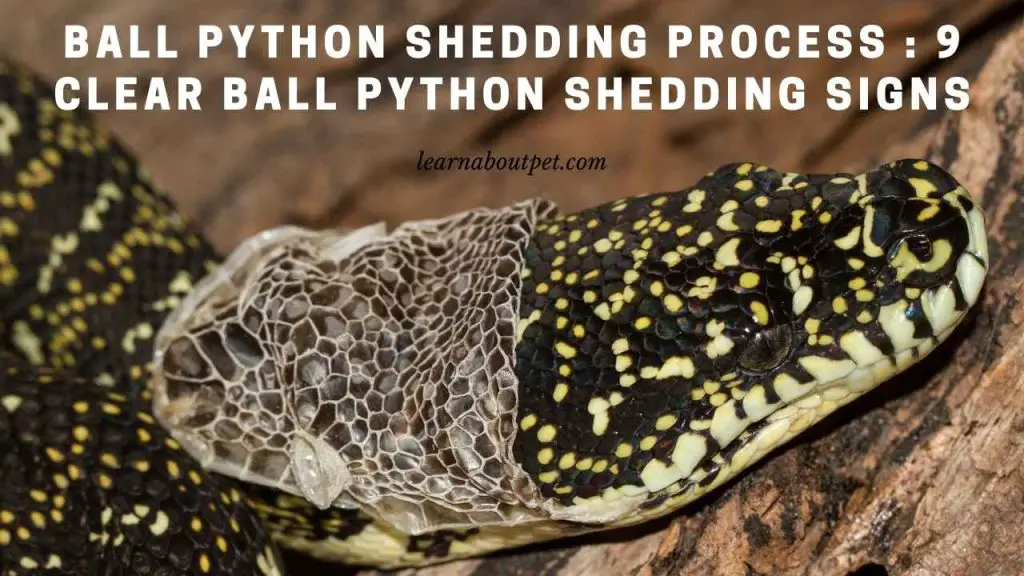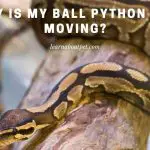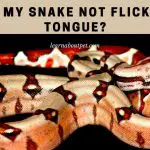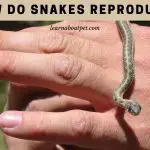All healthy ball pythons shed their skin from time to time. In this article, you will find comprehensive information on how the skin shedding process for a ball python goes.
The ball python shedding process typically takes between 9 and 14 days. It culminates in the ball python’s old skin sloughing off, to expose the new skin. Most ball pythons go through this process roughly every 4 to 6 weeks.
There are several ball python shedding signs, through which you can tell that your snake is about to shed its skin. A ball python that is about to shed will tend to become duller in appearance, with its belly turning pinkish.
Other ball python shedding signs include loss of appetite, lethargy and a tendency for the ball python to remain in its hide most of the time.
Through these ball python shedding signs, you can tell when the shedding process is about to start.

And whereas each snake is different, there is a typical ball python shedding process timeline through which you can tell how the process is progressing.
Thus to make sense of how far in the skin shedding process your snake is, you simply need to make reference to the said timeline.
The key thing to remember is that the ball python shedding process is an intensely stressful one for the snake. Any snake shedding process is intensely stressful.
Therefore whenever you observe your python shedding, you need to ensure that you don’t stress it further through things like undue handling.
You also need to make reference to the ball python shedding process timeline, to be sure that everything is going on as it should.
Why Do Ball Pythons Shed?
Any discussion on the ball python shedding process, ball python shedding process timeline or ball python shedding signs has to start with a word on why the ball pythons shed.
Once you understand why ball pythons shed, it becomes easier to make sense of the ball pythons shedding process. It also becomes easier to understand the ball python shedding signs, as well as the ball python shedding process timeline.
So, indeed, why do ball pythons shed? The core reason why ball pythons shed is in order to facilitate growth. It is important to remember that when a ball python’s body grows, its skin doesn’t grow with it.
With time, the old skin is outgrown.
Therefore as the ball python grows, it becomes necessary for it to shed the old skin, to make room for new skin that is better aligned with its growth status.
Shedding skin also allows the ball python to get rid of any parasites it may have accumulated.
After the skin shed, the snake starts on a new slate: with a fresh skin that is (for the time being at least) parasite-free.
What Does The Ball Python Shedding Entail?
At its core, the ball python shedding simply entails the python sloughing off its old skin, to expose its new skin.
Of course, before the actual sloughing off of the old skin, the python’s new skill will have been growing for a while.
Then once the new skin has grown properly, it will separate from the old one.
Finally, the python just sloughs off the old skin – ideally in one piece – to expose the new skin.
When do ball pythons shed for the first time? That is typically within a week from time of hatching.
There is a ball python shedding process timeline, on the basis of which the whole thing takes place.
The key thing to note is that the ball python’s old skin doesn’t come off in bits like, say, a lizard’s skin. On the contrary, it just sloughs off in one piece. So that is what the ball python shedding entails.
What Are The Major Ball Python Shedding Signs?
One of the key ball python shedding signs is skin becoming dull. The usually quite bright ball python skin becomes rather dull.
Another of key ball python shedding signs in the one in which the snake’s belly turns pink. This is in contrast to its normally cream color.
Yet another of key ball python shedding signs is the one in which the snake’s eyes become dull. This may entail the eyes becoming gray. Or it may entail them having a blue hue.
Thus if you find a ball python in blue eye color mode, you know that it is about to shed…
The question there is not whether the snake is about to shed. The question is when it will shed – which you may rephrase as “how long does it take a snake to shed after blue eye coloration’?
Lethargy is another of ball python shedding signs. Ball pythons become exceedingly lethargic when they are about to shed.
Further in the list of ball python shedding signs is loss of appetite. In fact, for the entire ball python shedding process timeline, there may be very little eating.
It is not uncommon for a ball python not to eat a morsel for the 9 to 14 days that it goes through the shedding process.
Shyness too may be said to be one of ball python shedding signs. So you find that the ball python prefers to spend the time it is shedding in its hide.
So this is how to tell if a snake is about to shed: by looking at those shedding signs. When it comes to the question of how to tell if your snake is shedding, these signs are very helpful.
Ball Python Shedding Process
The best way to describe the ball python shedding process is by making use of a timeline.
That timeline – the ball python shedding process timeline – runs for between 9 and 14 days.
We set the ball python shedding process timeline at 9 to 14 days because that is typically how long the shedding goes on for.
For the first 1 to 2 days in the ball python shedding process timeline, what you normally observe is the snake’s skin becoming duller. This is also when the belly starts turning from the normal cream color to pink(ish).
Moving onto days 3 to 7 in the ball python shedding process timeline, what you will normally observe are the eyes either becoming blue or gray. By now, the skin is fully dull.
In days 8 to 10 of the ball python shedding process timeline, the previously dull eyes will start becoming somewhat clear again. Even the body’s dullness may lessen now.
Days 9 to 14 is when the actual sloughing off of the old skin happens. So this is the most crucial phase of the ball python shedding process timeline.
At the critical point, the snake usually finds something rough to entangle the old skin on, then it sloughs it off.
It is the sloughing off of the old skin that marks the end of the ball python shedding process timeline.
But then again, if the skin doesn’t slough off in one piece, then that can be a complication. It leads to questions like those on how to help my snake shed the remaining skin. But we shall be looking at those later…
In normal cases, once the old skin sloughs off completely, the skin shedding is over.
Do Ball Pythons Eat During Shedding?
Many people express interest in knowing whether ball pythons eat during the shedding process.
In answering it, we first need to know whether snakes in general eat while shedding. So, do snakes eat when they shed? Or, to put it differently, do snakes eat while shedding?
What is the true position here: do snakes eat during shedding? The answer is largely ‘no’. Most snakes desist from eating while there are shedding.
Those that do eat while shedding usually do so very sparingly.
Thus if you had the do snakes eat during shed question, now you know the answer.
And if you had the how often do ball pythons eat while shedding question, that is the answer: they hardly eat while shedding.
Even if you research on the do snakes eat when they are shedding subject in brick and mortar libraries, most sources will tell you that they don’t.
That applies to ball pythons too. They mostly don’t eat while shedding. Those that eat while shedding do it very sparingly.
Remember, as we said earlier, one of the ball python shedding signs is utter loss of appetite.
Thus for the entire ball python shedding process timeline, you should expect very little feeding.
But right after the ball python shedding process timeline is complete, the snake normally requires a good meal.
Thus if you had the should I feed my ball python while shedding question, now you know the answer? If you must, do so very sparingly.
While at it, one may ask, how long after a snake sheds can you feed it? And the answer is that the snake’s appetite tends to return as soon as it completes shedding.
Thus you may start feeding the snake once it is through with shedding.
Can You Handle A Ball Python While Its Shedding?
It is best not to handle your ball python while it is shedding. This applies for the entire ball python shedding process timeline.
You need to remember that skin shedding is extremely stressful for the ball python.
Remember, the things we mentioned while we were discussing the ball python shedding signs? They include things like lethargy, loss of appetite, shyness and changes in appearance.
What becomes clear when you consider the whole range of ball python shedding signs is that the shedding is extremely stressful.
Being handled is also stressful for the snake. The reptile doesn’t need the stress of being handled, on top of the stress of shedding.
Handling can even lead to ball python shedding issues: mostly negative ones.
And a snake that is shedding is more likely to strike, when handled.
On account of these factors, it is best not to handle the ball python while it is shedding.
Just wait for the end of the ball python shedding process timeline. Then you can start handling the snake again.

How Often Does A Ball Python Shed?
Another question about ball python shedding that tends to come up is as to how often it happens.
So, indeed, how often do ball pythons shed? Or, to put it differently, how often should a ball python shed?
The answer is that healthy ball pythons typically shed after every 4-6 weeks. This too can be viewed as yet another ball python shedding process timeline.
Thus if your ball python sheds today, you need to be ready for another shedding in roughly 4-6 weeks.
Then again, the frequency of a ball python’s shedding also depends on its life stage. Young/juvenile ball pythons tend to shed more frequently than older ones.
That is because the younger ones have faster rates of growth.
To ascertain this, just research on how often do baby ball pythons shed. Or research on how often do young ball pythons shed. Then compare that with what you find, upon researching on how long elderly ball pythons shed.
You will see clearly that the young and fast growing ball pythons shed more often.
And this doesn’t apply to ball pythons alone. If you research on how often does a snake shed while it is young vis a vis when it is older, you see that it sheds more while younger.
Ultimately, every 4 to 6 weeks is how often ball pythons shed.
And if you had the how often should my ball python shed question, that is the answer to it.
But it is important to keep the life stages factor in mind, while answering the how often should ball pythons shed question.
In the earlier, fast growing life stages, ball pythons tend to shed more than in the latter slow growing life stages.
How Long Does It Take A Ball Python To Shed?
It can take as few as 9 and as many as 14 days for a ball python to shed. This is as per the ball python shedding process timeline we established earlier.
Thus if you had the how long does it take for ball pythons to shed question, this is the answer to it.
Even if you rephrase it as, how long does the shedding process take for a ball python, the answer remains 9 to 14 days.
Some ball pythons shed quite fast: such that they are through with it in 9 days. Others shed quite slowly, such that they need as many as 14 days to be through with it.
This is why giving a single answer to the how long is the ball python shedding process question is so hard.
In answering the how long for ball python to shed question, the best we can do is give a range. That is the best approach in answering the how long does shedding last ball python question.
Every snake is different. Some shed faster than others. Thus giving a single answer to the how long should it take a ball python to shed question is difficult.
But generally, if anyone poses the how long to ball pythons shed (or how long do ball pythons take to shed) question, the answer is 9-14 days. If it is faster than 9 days or slower than 14 days, it raises concerns.
By the way, this is not unique to ball pythons. If you research on questions like, how long does it take a snake to shed and how long does a snake shed take, you see similar nuances.
How Can You Help In The Ball Python Shedding Process?
Helping your snake shed mainly entails providing adequate humidity. You can help snake shed by, say, ensuring that humidity remains at roughly 70%.
If my snake is shedding, this is one of the key things I would pay attention to.
Thus for the entire ball python shedding timeline, you maintain humidity at around 70%.
If you keep ball python humidity during shed at that level, it tends to be quite easy for the old skin to slough off.
Conversely, low humidity can lead to a snake having trouble shedding.
For instance, due to low humidity, you may end up with the ball python shedding in pieces.
Thus you need to research on when do ball pythons shed. Then during those times, ensure the humidity remains at roughly 70%. Don’t allow it to fall below 50%.
Below that, it may be just a matter of time before you find yourself wondering, why isn’t my snake shedding in a wholesome manner?
For instance, you may find that the snake still has shed on his head right at the end of the ball python shedding process timeline.
Or, due to poor humidity, you may find yourself wondering, why does my snake keep shedding in pieces (while it is supposed to slough off the old skin at once)?
If you research on how do I help my snake shed, you will see that another thing you need to do is provide a rough surface, against which it can rub to slough off the old skin.
That can be particularly useful when it comes to how to help a snake shed its head skin.
Once you help ball python shed the skin on head (around nose) first, the rest tends to slough off easily.
What Should You Do In Case Of A Stuck Ball Python Shedding Process?
Sometimes, the ball pythons shedding process doesn’t go as expected.
Earlier, we gave a ball python shedding process timeline. It works in most cases. But there are a few cases in which it doesn’t work.
So that is how you end up with a ball python stuck shed. The stuck shed ball python experiences means that the old skin doesn’t wholly slough off, as expected.
It may be a case of the snake shedding in bits. And that gets you wondering, why is my ball python shedding so much in bits (yet the skin should slough off at once)?
And you also wonder, how can I help my snake shed in one piece, as expected?
Or you start asking, my ball python is having trouble shedding in one piece, what should I do?
Now in the case of a ball python not shedding in one piece, there are several things you can do. This is with regard to how to help your snake finish shedding.
You can put several damp towels in the ball python’s enclosure. Then maintain the temperature in the 81 to 89 Fahrenheit range, from evening to morning.
Alternatively, you put the ball python into a wet damp pillowcase, which you then keep within a tub, below a heating source.
These measures can then help your python in completing the shedding process.
So in the context of how to help your ball python shed, these are helpful measures.
With regard to how to help my ball python shed properly, these are measures I would use.
And if you had the question on what to do when ball python is shedding in pieces, right there is the answer.
Do Ball Pythons Eat Their Shed?
We can’t complete a discussion on ball python shedding process timeline without addressing the issue of whether these snakes eat their shed.
So, do ball pythons eat their shed? The answer seems to be ‘no’, for the most part.
This is why right after the ball python shedding process timeline, you need to clear the old/shed skin. So you collect it using gloves, and dispose of it properly.
How Do You Know When The Ball Python Shedding Process Is Complete?
As noted earlier, the ball python shedding process timeline typically runs for 9 to 14 days.
You know that the shedding is complete once you inspect the snake and find that it has successfully wholly sloughed off the old skin, exposing the new skin throughout its body.
In case there are bits of the old skin still on its body, you will know that shedding hasn’t been entirely successful.
So you will need to go back to the subject of how to help ball python shed completely.
Earlier, we gave tips on how to help a ball python shed fully (even if it was shedding in small bits).
So those are the tips you act on, when a ball python is shedding in bits.
It is important to know, what does a ball python look like when shedding? Knowledge on how do ball pythons act when shedding is also important.
Further, you need some basic understanding of what are the stages of snake shedding?
All these will in turn be helpful in knowing when the ball python shedding process timeline is complete.
In case there are problems – like incomplete shedding, which is an infection hazard – you can figure out how to help your snake shed completely.
Final Verdict – Ball Python Shedding Process
The ball python shedding process starts at the time when a new skin starts developing.
But the actual ball python shedding process timeline starts ticking when the snake’s skin becomes dull. This is the first of the ball python shedding signs.

Eventually, the ball python’s eyes become either gray or blue. And its belly changes from the normal cream color, to pinkish.
The actual shedding entails the snake hooking its old skin on some rough edge, then sloughing over it. Ideally, the snake’s old skin should slough off in one piece.
You can help your ball python in the shedding process by seeing to it that humidity levels in its enclosure remain high. That is ideally at 70%.
Providing a rough surface against which the ball python can rub in order to slough off the old skin can also be helpful.
As a pet lover, make sure to learn about pet more and give your pet snake a good and comfortable life!

Welcome to Learn About Pet. My name is Rajkumar Ravichandran and I love all pets, travel, and amazing food. I write about my passion and personal experience caring for multiple pets in this blog! ❤️
Post Disclaimer
DISCLAIMER: THIS BLOG OR WEBSITE, "Learn About Pet", DOES NOT PROVIDE YOU WITH MEDICAL ADVICE AND IS NOT A SUBSTITUTE FOR MEDICAL ADVICE. ALWAYS GET IN TOUCH WITH YOUR PERSONAL VETERINARIAN AND USE INFORMATION HERE AS GENERAL ADVICE.
The information, including but not limited to, text, graphics, images and other material contained on this website are for informational purposes only. No material on this site is intended to be a substitute for professional veterinary advice, food recommendation, diagnosis, or treatment. Always seek the advice of your veterinarian or other qualified health care provider with any questions you may have regarding a medical condition or for pet food related questions.







